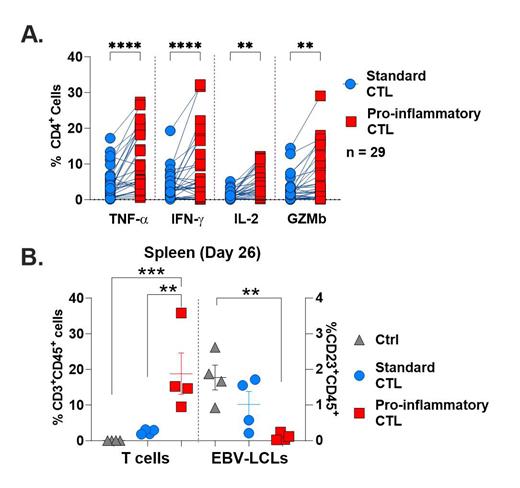Background: Epstein-Barr virus (EBV), a human gamma herpesvirus primarily of B-cell tropism that infects more than 90% of humans during childhood, establishing a lifelong latent persistence after the initial immune clearance. Alterations in the immune surveillance in subjects with impaired cellular immunity can lead to viral reactivation and uncontrolled B cell lymphoproliferation manifesting as post-transplant lymphoproliferative disease (PTLD) and malignant transformation into B-cell lymphomas and some epithelial tumors. Adoptive transfer of virus-specific cytotoxic T cells targeting viral oncoproteins of EBV (EBV-CTLs) may lead to rapid reconstitution of T cell immune surveillance and may efficiently control PTLD and some EBV-driven lymphomas. However, success of this approach has been hampered by suboptimal/variable potency of donor-derived EBV-CTLs and possibly their terminally differentiated/exhausted phenotype associated with limited in vivo persistence and activity, especially when targeting elusive Latency 1-associated diseases. We hypothesized that that EBV-specific CD4 + T cells differentiated using novel pro-inflammatory conditions might efficiently target viral oncoproteins concurrently retaining highly desirable stem-cell like properties required for successful eradication of tumor cells in vivo.
Methods: In this study, we developed a method for generating novel and highly potent CD4 + cytotoxic T cells (CD4 +-CTLs) simultaneously targeting EBNA1, LMP1, and LMP2A. Peripheral blood mononuclear cells (PBMCs) were isolated from healthy donors, and either total T cells or CD4 +T cells were purified. These cells were then stimulated with PBMCs loaded with overlapping peptide libraries spanning LMP1, LMP2A, and EBNA1 antigens, either under neutral conditions (IL2 and IL-7) or in the presence of pro-inflammatory (type 1/17) cytokines ex vivo for 12-14 days. The phenotypes, reactivity, and cytotoxic capability of these CD4 +-CTLs against autologous EBV-Lymphoblastoid cell lines (LCLs) were assessed in vitro and in vivo upon adoptive transfer into tumor-bearing NSG mice.
Results: In comparison to EBV-CTLs generated from unselected PBMCs (standard conditions), purified CD4 + expanded in the presence of pro-inflammatory cytokines exhibited significantly higher frequency of antigen specific T cells with a marked skewing towards EBNA1 antigen, and displaying marked polyfunctionality, concurrently secreting tumor necrosis factor-α (TNF-α), interferon-γ (IFN-γ), and inducible granzyme B (GzmB), while maintaining interleukin-2 (IL-2) secretion capacity. Antigen-reactive CD4 +-CTLs induced in pro-inflammatory conditions retained a significant population with central memory (T CM) phenotype (CCR7 hi, CD27 hi), while those expanded in neutral conditions predominantly displayed an effector memory (T EM) phenotype. These CD4 +-CTLs demonstrated enhanced cytotoxicity against autologous EBV-LCLs and superior proliferative capacity in vitro upon secondary stimulation, whereas standard EBV-CTLs proliferated poorly. In the LCL-injected NSG mice, CD4 +-CTLs exhibited superior self-renewal and long-term persistence, resulting in a significant reduction/eradication of established LCL burden when compared to standard EBV-CTLs.
Conclusion:Ex vivo priming with EBV antigens in the presence of pro-inflammatory cytokines reliably induces EBV-reactive CD4 +-CTLs with markedly enhanced antigen-specificity, polyfunctionality, cytotoxic potential, preserved stemness, proliferative capacity, and superior in vivo persistence and anti-tumor activity . These findings hold significant promise for developing improved adoptive immunotherapies to target EBV-associated diseases, especially of Latency-I origin and may be generalized as a strategy for targeting other viral oncoproteins expressed by human cancers.
Figure 1: EBV-CD4 + CTLs generated under pro-inflammatory conditions display superior reactivity, persistence, and anti-tumor activity in vivo: (A.) The percentage of CD4 +Th cells primed with LMP1/2 and EBNA1 and expanded under indicated conditions producing TNF-α, IFN-γ, IL-2 and GZMB upon antigenic restimulation (n=29). (B.) Frequency of EBV-LCLs (CD23 +) and CD3 + cells detected in spleens on Day 26 post adoptive transfer of standard and pro-inflammatory EBV-CD4 + CTLs(n=4 per group).
Disclosures
Muranski:Lyell Immunopharma: Consultancy, Membership on an entity's Board of Directors or advisory committees.


This feature is available to Subscribers Only
Sign In or Create an Account Close Modal